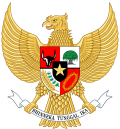| |||||||||||||||||||||||||||||||||||||||||||||||
| |||||||||||||||||||||||||||||||||||||||||||||||
| |||||||||||||||||||||||||||||||||||||||||||||||
| This article is part of a series on the |
| Politics of Indonesia |
|---|
 |
Elections were held in Indonesia on 15 December 1955 to elect all 514 members of the Constitutional Assembly. The Provisional Constitution of 1950 had provided for the establishment of an elected body to draw up a permanent constitution following Indonesia's independence from the Netherlands. [1] In April 1953, the House of Representatives passed the election bill. The elections for the house were set for September 1955, while those for the Constitutional Assembly were held three months later.



